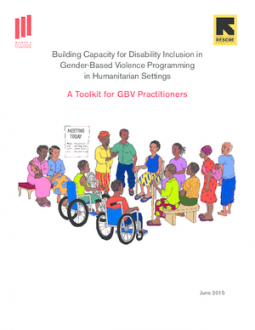
"I See That It Is Possible" Gender-based Violence Disability Toolkit
PublishedDisability Inclusion in Gender-based Violence (GBV) Programming
The tools are designed to complement existing guidelines, protocols and tools for GBV prevention and response, and should not be used in isolation from these. GBV practitioners are encouraged to adapt the tools to their individual programs and contexts, and to integrate pieces into standard GBV tools and resources.
Complete Toolkit
Toolkit Overview
Tool #1: Guidance on including persons with disabilities and caregivers in GBV assessments
This guidance note describes the general principles and approaches to conducting assessments with persons with disabilities and their caregivers in humanitarian settings.
Tool #2: Group discussion guide
This tool describes participatory activities and questions to be used in group discussions with persons with disabilities and caregivers.
Tool #3: Individual interview tool
This tool provides an alternative to group sessions. It can be used for one-on-one interviews with persons with disabilities and caregivers who are isolated in their homes, and with people who may prefer one-on-one communication in a familiar environment.
Tool #4: Gender-based violence and disability: A training module for GBV practitioners in humanitarian settings
This training module is designed to support GBV practitioners to understand the intersections between disability, gender, and violence in the communities where they work, and to develop strategies to improve the inclusion of persons with disabilities in GBV prevention and response programming.
Tool #5: Pre- and post-training test for the GBV and disability training module
This test can be used with GBV practitioners to identify changes in their knowledge and attitudes relating to disability inclusion, and is accompanied by an answer key for scoring the tests. It should be used in conjunction with the GBV and disability training module.
Tool #6: Guidance on communicating with people with disabilities
This tool provides simple tips and advice for GBV practitioners on interacting and communicating with persons with different types of impairments.
Tool #7: Accessible information, education and communication (IEC) materials
This tool provides fi ve key questions to ask when developing IEC materials to ensure they are disabilityinclusive, with a practical example from a refugee setting.
Tool #8: Applying the guiding principles when working with survivors of disabilities
This tool provides fi ve key questions to ask when developing IEC materials to ensure they are disabilityinclusive, with a practical example from a refugee setting.
Tool #9: Informed consent process with adult survivors with disabilities
This tool outlines general principles and steps for obtaining informed consent with adult survivors with disabilities.
Tool #10: Working with caregivers of survivors with disabilities
This tool offers guidance on how to approach working with caregivers of survivors with disabilities to ensure all needs are met and positive relationships are strengthened.
Tool #11: Reflection tool for GBV practitioners
This participatory activity supports GBV practitioners to refl ect on changes in their attitudes, knowledge and practices relating to disability inclusion, as well as to identify successes and set goals for further capacity development.
Tool #12: Documenting “Stories of Change”
Stories of change help identify what activities have been most important to women, men, girls, and boys with disabilities and their caregivers, the facilitators and barriers to their inclusion, and their suggestions for change.
Additional Tool: Identifying skills and capacities of persons with disabilities
This tool has been developed by the WRC to support GBV practitioners to identify the skills and capacities of persons with disabilities that may be useful in both case management with survivors and supporting participation in empowerment activities.

